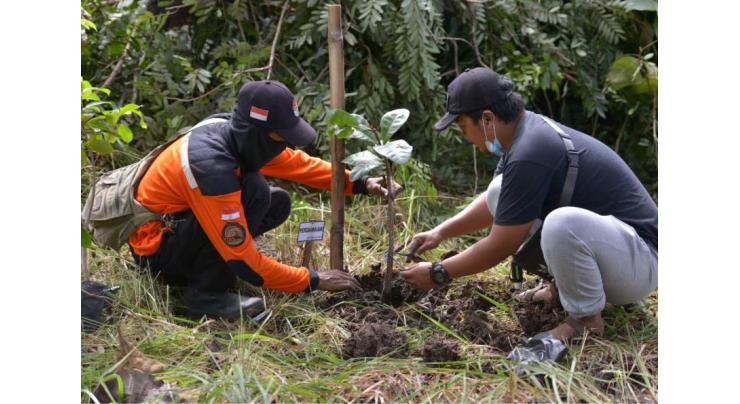
Canopy Trees' Plantation Vital To Bring Rains, Control Rising Temperature
Mohammad Ali (@ChaudhryMAli88) Published May 22, 2024 | 10:39 PM

Assembled under a Shisham tree for collective meal after crushing of wheat, Kamal Ali along with his brothers and fellow farmers were seen sewing wheat sacks by using shads of canopy trees to avoid scorching heat
PESHAWAR, (UrduPoint / Pakistan Point News - 22nd May, 2024) Assembled under a Shisham tree for collective meal after crushing of wheat, Kamal Ali along with his brothers and fellow farmers were seen sewing wheat sacks by using shads of canopy trees to avoid scorching heat.
Repeatedly asking his brothers and co labourers to hurry up to sew all 100 bags and shift it to godwon at home before sunset at village Mohib Banda Nowshera, Kamal told APP that trees plantations was the hobby of his late father Hamyun Khan and today his love for trees is greatly help protect them from the sizzling heat.
Followed the footprints of his father, the motivated farmer had planted 500 shisham saplings on my farm lands keeping in view of its enermous benefits especially averting of heat in Pakistan.
Pakistan is a unique country in South Asia blessed with numerous varieties of indigenous tall canopy trees including Shisham extremely beneficial to increase chances of rains besides mitigating the adverse effects of climate change, global warming and air pollution.
An abode to world tallest shady trees mostly found in Hamalya, Karakuram to Hindokush mountains ranges, Pakistan's coastal areas of Karachi and Gwadar, alpine pasture Malakand, Hazara, Muree, AJK and GB beside arid zones of DI Khan, DG Khan, Cholistan, Bahawalpur and Tharparker, are acting as purifiers of environment by significantly enhancing chances of rain, producing oxygen, absorbing carbon dioxide, controlling temperature and air pollution in the country.
The national tree of Pakistan, Deodar and other famous species including Kail, Spruce and Walnut are being found in relatively cold climate areas of Swat, Chital, Kohistan, Dir, Gilgit Baltistan and AJK whereas Punjab and KP are the epicenters of native Shisham, Siris, Pipal, Bakin, Amaltas, Willow, Poplar, Mulberry, Phulai, Alstona, Kachnar, Bottle Brush, Gul e Nashtar and Jaman.
Kikar, Neem, Beera at Sindh and mangroves at coastal areas of Karachi, Thatta and Balochistan and endangered juniper trees at Ziarat near Quetta are easiest sources to counterbalance growing effects of climate change and air pollution besides bolstering chances of rains in Pakistan.
"Pakistan is bestowed with more than 200 native trees and nine different forest ecological systems hardly found in any other country of world," Muhammad Tehmasip, former Project Director, PTI Government's Billions Trees Afforestration Project (BTAP) told APP.
He said, "one healthy shady tree provides oxygen to two to four persons and 1075 plants on one hectare land absorb six to eight tons carbon dioxide on daily basis.”
"Trees are a main source of absorbing carbon dioxide and producing oxygen for people and bolstering chances of rains," he said.
Due to increase in global warming, he said, change had been witnessed in normal patterns of rains in recent years across the globe including Pakistan and resultantly disturbed the weather pattern.
He said that on average 267.6mm rainfall per year occur in Pakistan, and areas with thick forests normally receive more rains like upper Punjab and KP.
KP province has a rich ecological biodiversity with 26.6pc expanded forest covered area and its Galyat, Kaghan, Naran, Malam Jabba and Kalam receive substantial rainfall due to forest cover.
Peshawar valley had been once the stronghold of endangered Shisham, Siris and Pepal and a thick forest here was a source of rains for people, habitat for wildlife and control of pollutant gases.
The history revealed that first Mughal Emperor, Zaheer-ud-Din Babar in his book "Tuzkay Babari" had written about hunting of a lion in the outskirts of Peshawar, which manifested presence of a dense forest here.
During King Sher Shah Suri, (1486-1545) era, Shisham was planted in large number along GT roadside in present KP. With a passage of time, the population of these abating trees had significantly decreased in Peshawar Valley comprising Mardan, Swabi, Nowshera and Charsadda districts due to mushroom population growth, urbanization, unabated housing and construction activities.
A new visitor would be extremely disappointed if goes through Swat canal linking Katlang-Swabi, Michi canal in Dargai Malakand, Abazai beanch in Charsadda and outskirts of Peshawar to see hundreds of withered Shisham.
Today even birds like Cranes and Houbara Bustard can hardly be seen in the Peshawar's outskirts for which once it was famous for in addition to substantial decrease of aquatic species including Mahsher and Trout in rivers Swat and Kabul due to rising temperatures and water pollution.
Due to deforestation, air pollution has engulfed Peshawar, which could be seen even with a naked eye these days, exposing people to serious environmental and health hazards.
Muhammad Irshad, Chief Analyst, Environmental Protection Agency (EPA) told APP that canopy trees were a great source of controlling dangerous PM 2.5 level pollution. PM 2.5 is a complex mixture of extremely small and light particles staying for longer period in air and once inhaled, can affect peoples' hearts, nose to lungs, respiratory system besides leading to high blood pressure, strokes, asthma, cancer and other chronic diseases.
The minimum level of PM 2.5 in Peshawar’s air is about 40micrograms (mg) per cubic meter and maximum 52mg per cubic meter while NEQS recommended level of tiny particles in air should not be more than 15mg per cubic meter.
He said EPA had conducted a scientific study in Peshawar and recorded 52mg/m3 higher dust and smoke particulate in air which normally should be 15mg/m3 as per NEQS standards.
"The smoke and dust in air was measured between five to 10 feet higher in different places where PM2.5 is almost four times higher than NEQS limits,” he said adding, canopy trees with 10 feet or more height have the ability to absorb such high level of carbon dioxide and pollutant gases in Peshawar.
To quickly fill up native trees' deficiency, exotic trees like eucalyptus was imported from Australia in the past and planted in large quantity in the water starved Pakistan due to its high growth rate despite absorbing huge water contrary to our native species adversely affecting water table.
"A large number of trees are planted during spring and monsoon afforestation campaigns every year in Pakistan including KP but many disappear with a passage of time because of wrong selection of saplings for different climate zones, ill-planning and improper care," Dr Muhammad Mumtaz Malik, former Wildlife Department Chief.
In-spite of unsuccessful experiences of plantation of Dates (Kajoor) trees on Quaid-e-Azam Highway at Blue Area Islamabad, he regretted that the same mistake was repeated on Islamabad-Peshawar Motorway where dates' plants were planted in substantial quantity contrary to the area’s climate conditions, resultantly they are highly vulnerable to die pre-maturely and their overall growth were affected.
Despite numerous qualities of cost efficient native trees, he said, preference was still being given to eucalyptus and fashionable small-sized bushy plants which scarcely have the power to fight pollutant gases.
Fazal Elahi, Chief Conservator KP Forest Department said that first man made forest on pattern of ‘Changa Manga’ had been raised on over 32,000 hectares at Ghari Chandan near Peshawar where millions of saplings mostly native plants were planted to control the rising temperature and air pollution besides bolstering chances of rains.
He said that preference were given to conopy trees in billion trees project to control rising temperature and air pollution.
Elahi said that CM KP has directed for launching of billion trees project plus under which focus would be given to plantation of conopy trees to combate scorching heat and air pollution besides increase chances of rains during summer
Related Topics
Recent Stories

Currency Rate In Pakistan - Dollar, Euro, Pound, Riyal Rates On 19 June 2024

Today Gold Rate in Pakistan 19 June 2024

Currency Rate In Pakistan - Dollar, Euro, Pound, Riyal Rates On 18 June 2024

Today Gold Rate in Pakistan 18 June 2024

Currency Rate In Pakistan - Dollar, Euro, Pound, Riyal Rates On 17 June 2024

Today Gold Rate in Pakistan 17 June 2024

PTV’s “Esaar Abad” to premiere on Eid ul Adha

ICC T20 World Cup 2024: Pakistan opt to field first against Ireland

Currency Rate In Pakistan - Dollar, Euro, Pound, Riyal Rates On 16 June 2024

Today Gold Rate in Pakistan 16 June 2024

S.Africa's Ramaphosa to announce 'inclusive' coalition cabinet

4 Labourers die of suffocation during cleanliness of manhole
More Stories From Pakistan
-
PM lauds Punjab CM, her team over cleanliness services during Eid days
10 seconds ago -
Partly cloudy weather likely to persist in city
12 seconds ago -
Mayor hails SMC for successful cleanliness drive on Eid-ul-Azha
10 minutes ago -
Three drug dealers held; drugs, arms recovered
10 minutes ago -
People flock to fun places to celebrate Eid
30 minutes ago -
19,302 tons waste removed from Faisalabad: DC
30 minutes ago
-
Man drowns in Indus river
30 minutes ago -
CDA sanitary staff appreciated for keeping capital clean during three days of Eid ul Azha: Chairman
30 minutes ago -
Wild animals at Peshawar zoo draws children influx on Eid holidays amid funfair, excitement
40 minutes ago -
Nutritious food provided to prisoners across Punjab: home secretary
50 minutes ago -
PM strongly condemns killing of Landi Kotal senior journalist
50 minutes ago -
Thousands throng Murree to enjoy pleasant weather in Eid holidays
1 hour ago